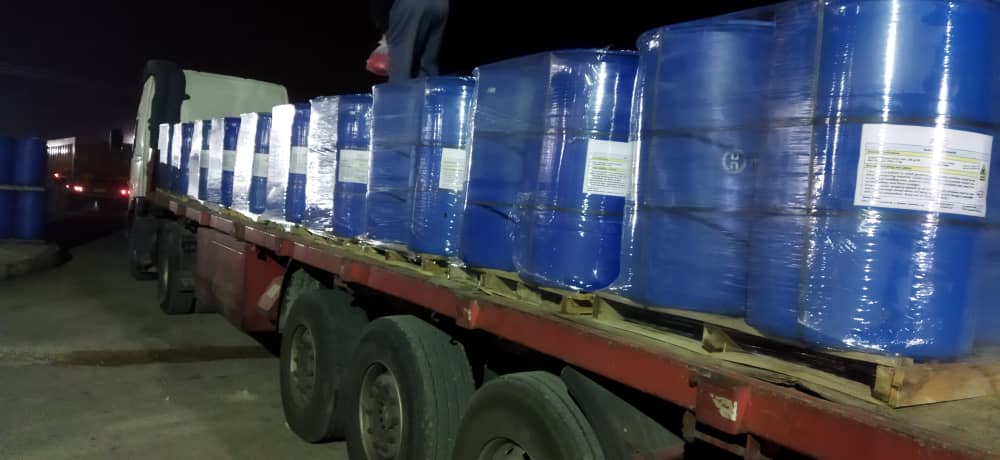sodium hypochlorite

Sodium Hypochlorite Description
Sodium hypochlorite (NaClO), commonly known as bleach, is a solution made from reacting chlorine with a sodium hydroxide solution. These two reactants are the major co-products from most chlor-alkali cells. Sodium hypochlorite, commonly referred to as bleach, has a variety of uses and is an excellent disinfectant/antimicrobial agent.
Reacting chlorine and sodium hydroxide will produce sodium hypochlorite:
Cl2 + 2NaOH = NaOCl + NaCl + H2O
Sodium hypochlorite is available as a solution in concentrations of 5 to 15% chlorine. Sodium hypochlorite is easier to handle than chlorine gas or calcium hypochlorite. It is, however, extremely corrosive and should be kept away from equipment that could be damaged by corrosion. Hypochlorite solutions decompose and should not be stored for more than 1 month and must be stored in a cool, dark, dry area.
Sodium Hypochlorite Characteristic
Sodium hypochlorite is a clear, slightly yellowish solution with a characteristic odor.
Sodium hypochlorite has a relative density of is 1,1 (5,5% watery solution).
As a bleaching agent for domestic use it usually contains 5% sodium hypochlorite (with a pH of around 11, it is irritating). If it is more concentrated, it contains a concentration 10-15% sodium hypochlorite (with a pH of around 13, it burns and is corrosive). The ideal pH of the solution should be from 11.86-13 pH or approximately 0.25% to 0.35% excess caustic (NaOH).
Sodium hypochlorite is unstable. Chlorine evaporates at a rate of 0,75 gram active chlorine per day from the solution. Then heated sodium hypochlorite disintegrates. This also happens when sodium hypochlorite comes in contact with acids, sunlight, certain metals and poisonous and corrosive gasses, including chlorine gas. Sodium hypochlorite is a strong oxidator and reacts with flammable compounds and reductors. Sodium hypochlorite solution is a weak base that is inflammable.
These characteristics must be kept in mind during transport, storage and use of this product.
Sodium Hypochlorite Production Process Methods
There are two different methods that can be used to produce SH.
The first is to use an electrolysis system to dissolve salt in softened water, producing a liquid brine. When this solution is electrolyzed, SH is produced. Hydrogen gas, which is highly explosive, is also produced during this reaction, so it is important that safety measures are taken before, during and after producing SH in this manner. The advantage of the salt electrolysis system in the creation of sodium hypochlorite is that no transport or storage of chemicals are required, however, the costs to purchase and maintain the electrolysis system are typically higher than that of a batch or continuous process.
Alternatively, it can be produced by adding chlorine in gaseous form to caustic soda. Most commonly, sodium hypochlorite is made via chemical reaction. In this case, it is prepared by reacting dilute caustic soda solution with liquid or gaseous chlorine, accompanied by cooling, eventually producing sodium hypochlorite, water, and salt
Sodium Hypochlorite Hazards/Precautions
- Never mix Sodium Hypochlorite, with acidic solutions or Ammonia. Doing so forms a dangerous gas potentially leading to choking and breathing difficulty.
- Avoid swallowing and getting sodium hypochlorite in the eyes or on the skin. Depending on the strength of sodium hypochlorite, severity can range from mild irritation to severe burns.
- In the event sodium hypochlorite is swallowed, seek emergency help immediately. If the affected person is alert, give them milk or water to drink. Do not induce vomiting. Seek immediate medical attention.
- Skin or eyes should be immediately flushed continuously and thoroughly if coming into contact with sodium hypochlorite. Seek immediate medical attention.
- In the event of inhalation of sodium hypochlorite, leave the affected area and seek fresh air. If breathing is difficult, administer oxygen and seek immediate medical attention.
Advantages of Sodium Hypochlorite
Some of the notable advantages are:
- similar disinfectant efficiency as chlorine;
- safer to handle and store than chlorine;
- Kills the majority of live pathogens in water;
- Is relatively cheap and can be used to economically disinfect large amounts of water;
- Has quite a long shelf-life as it can be stored for up to two months.
- easy stored and transported when it is produced on-site
- it produces residual disinfectant
Disadvantages of Sodium Hypochlorite
Some of the biggest disadvantages of sodium hypochlorite are:
- Loses potency when in contact with air, so must be stored correctly;
- Is still a dangerous and corrosive chemical, although not as unsafe as chlorine;
- Is not capable of deactivating Giardia Lamblia and Cryptosporidium;
- May produce harmful byproducts when used as a disinfectant in municipal drinking water.
Advantages Of Filtered Sodium Hypochlorite
The filtering of sodium hypochlorite (SH) offers numerous advantages. Some of these advantages are as follows:
- You can produce SH using any quality of sodium hydroxide, including diaphragm cell caustic. This gives you a wider choice of suppliers which usually results in lower material cost and subsequent reductions in production costs.
- You can sell your higher quality product at a higher price, a basic principle of supply and demand.
- High purity SH does not decompose as rapidly as standard grade, so you can reduce the strength of the product you produce.
- Oxygen formation is significantly lower. As a result, product safety is improved allowing customers to package product without bottles swelling due to oxygen formation.
- Costly customer quality complaints relating to oxygen and solids formation in storage tanks, pumps and piping are eliminated.
- After filtration, sniff gas bleach can be sold as high-quality bleach.
- Virtually all contaminants are removed during final filtration so most plant wastewater, including filter backwash water, containment area drains, water softener backwash and other wastewater can be reused to make bleach. Many plants using the Powell system have no wastewater connects to sanitary sewer systems.
Sodium Hypochlorite Application
Sodium hypochlorite is used on a large scale. For example in agriculture, chemical industries, paint- and lime industries, food industries, glass industries, paper industries, pharmaceutical industries, synthetics industries and waste disposal industries.
In the textile industry it is used to bleach textile. It is sometimes added to industrial waste water. This is done to reduce odors. Hypochlorite neutralizes sulphur hydrogen gas (SH) and ammonia (NH3). It is also used to detoxify cyanide baths in metal industries.
Hypochlorite can be used to prevent algae and shellfish growth in cooling towers. In water treatment, hypochlorite is used to disinfect water. In households, hypochlorite is used frequently for the purification and disinfection of the house.
Sodium Hypochlorite is a bleach or disinfectant, and is capable of killing pathogens like bacteria, viruses, fungi and mycobacterium. It can be used as a household cleaner, thanks to its destaining properties, and may also be an ingredient in laundry detergents and deodorizing products.
Industrial uses of sodium hypochlorite include use in chemical, food and glass factories, as well as in waste disposal and pharmaceutical industries. It can also be used to bleach textiles, and may be used to reduce odors in industrial wastewater. Additionally, it can prevent the growth of algae in cooling towers.
It’s also very common for Sodium Hypochlorite to be used as a disinfectant in swimming pools. Additionally, this chemical is used around the world in industrial and municipal water treatment applications, making water clean and safe to drink.
Sodium Hypochlorite Analysis
| R | CONTENT | RAHA SPEC | ACCEPTING LIMIT | UNIT | TEST METHOD |
|---|---|---|---|---|---|
| 1 | Active Chlorine | ≥ 15 | Min 120 | g/L | ISIRI-1994 |
| 2 | NaOH | 1 | Min 0.5 | %W/V | ISIRI-1994 |
| 3 | Na2CO3 | ˂ 0.2 | Max 1 | %W/V | ISIRI-1994 |
| 4 | NaClO3 | 0.2 | Max 0.7 | %W | ISIRI-1994 |
| 5 | Fe | ˂ 1 | Max 3 | PPM | ISIRI-1994 |
| 6 | Heavy Metals | ˂ 0.2 | Max 0.5 | PPM | ISIRI-1994 |
| 7 | Color | Yellow or Yellowish Green | Yellow or Yellowish Green | __ | ISIRI-2361 |
| 8 | Appearance | Clear Solution Sediment Free | Clear Solution Sediment Free | __ | ISIRI-2361 |

